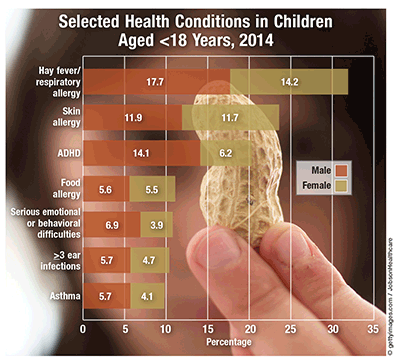US Pharm. 2017;42(5):12.
According to the National Center for Health Statistics, the health status of children aged 5 to 11 years is excellent or very good overall, at 84.8%, but 3.2% of children miss 11 or more days of school in a year because of illness or injury. It was found that 17.4% of children are obese, 4.5% of children do not have health insurance coverage, and 4% of children lack a usual source of healthcare. The death rate among children aged 5 to 14 years is 12.7 per 100,000. Leading causes of death among children aged 5 to 14 years include accidents, cancer, and intentional self-harm.

Serious Emotional or Behavioral Difficulties: According to the National Institute of Mental Health, emotional and behavioral disorders affect 10% to 15% of children around the world. Approximately 3% to 5% of children worldwide have a diagnosis of attention-deficit/hyperactivity disorder. Of all health conditions in children, attention-deficit/hyperactivity disorder is the most prevalent condition across ethnic groups (standard deviation, 4.5).
Allergies: The second most common health condition across various ethnic groups is skin allergies (standard deviation, 3.6), which in 2011 afflicted 69% more children than in 1997 (12.5% vs. 7.4%). With the progression of age, the rate of prevalence of skin allergies decreased from 14.2% (in children aged <4 years) to 13.1% (in children aged 5-9 years) and, finally, to 10.9% (in children aged 10-17 years). The rate of prevalence of food allergies increased from 3.4% in 1997 to 5.1% in 2011. For all health conditions, the prevalence of food allergies has had the least variability (standard deviation, 0.8) across all ethnic groups. Hay fever affects up to 30% of all people worldwide, including up to 10% of U.S. children younger than 17 years of age and 7.8% of U.S. adults. The medical cost of allergic rhinitis is approximately $3.4 billion, and this figure is due mostly to the cost of prescription medications. With aging, the prevalence of allergic rhinitis has increased from 10.8% (in children aged <4 years) to 17.4% (in children aged 5-9 years), and then to 20.8% (in children aged 10-17 years).
Asthma: Although 13% of children have had asthma at any point in their lifetime, 8.4% of children (6.2 million) still have asthma, and boys outnumber girls by 43.5% in experiencing this disorder. The prevalence of asthma is greater among residents of the Northeast (9.8%) and the South (9.6%) than in residents of other regions of the U.S. (7.5%).
To comment on this article, contact rdavidson@uspharmacist.com.





